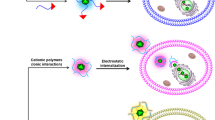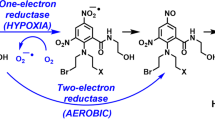Abstract
Endovenously administered oncolytic viruses extravasate and penetrate poorly into tumors. iRGD is a cyclic peptide that enhances tumor penetration when conjugated or coadministered with different types of molecules such as drugs, nanoparticles or phages. iRGD-mediated tumor penetration occurs in three steps: binding to αv-integrins on tumor vasculature or tumor cells, exposure by proteolysis of a C-terminal motif that binds to neuropilin-1 (NRP-1) and cell internalization. We have genetically inserted the iRGD peptide in the fiber C terminus of ICOVIR15K, an oncolytic tumor-retargeted adenovirus to increase its tumor penetration. In vitro, NRP-1 interaction improved binding and internalization of the virus in different cancer cells overexpressing integrins and NRP-1. However, such NRP-1-mediated internalization did not affect transduction or cytotoxicity. In vivo, iRGD did not change the normal organ transduction pattern, with liver and spleen as main targeted organs. In tumors, however, iRGD enhanced transduction and early adenovirus dissemination through the tumor mass leading to an improved antitumor efficacy.
This is a preview of subscription content, access via your institution
Access options
Subscribe to this journal
Receive 12 print issues and online access
$259.00 per year
only $21.58 per issue
Buy this article
- Purchase on Springer Link
- Instant access to full article PDF
Prices may be subject to local taxes which are calculated during checkout





Similar content being viewed by others
References
Pesonen S, Kangasniemi L, Hemminki A . Oncolytic adenoviruses for the treatment of human cancer: focus on translational and clinical data. Mol Pharm 2011; 8: 12–28.
Alemany R . Chapter four—design of improved oncolytic adenoviruses. Adv Cancer Res 2012; 115: 93–114.
Coughlan L, Alba R, Parker AL, Bradshaw AC, McNeish IA, Nicklin SA et al. Tropism-modification strategies for targeted gene delivery using adenoviral vectors. Viruses 2010; 2: 2290–2355.
Jain RK, Stylianopoulos T . Delivering nanomedicine to solid tumors. Nat Rev Clin Oncol 2010; 7: 653–664.
Russell SJ, Peng KW, Bell JC . Oncolytic virotherapy. Nat Biotechnol 2012; 30: 658–670.
Oh P, Li Y, Yu J, Durr E, Krasinska KM, Carver LA et al. Subtractive proteomic mapping of the endothelial surface in lung and solid tumours for tissue-specific therapy. Nature 2004; 429: 629–635.
Neri D, Bicknell R . Tumour vascular targeting. Nat Rev Cancer 2005; 5: 436–446.
Liu Y, Deisseroth A . Tumor vascular targeting therapy with viral vectors. Blood 2006; 107: 3027–3033.
Dmitriev I, Krasnykh V, Miller CR, Wang M, Kashentseva E, Mikheeva G et al. An adenovirus vector with genetically modified fibers demonstrates expanded tropism via utilization of a coxsackievirus and adenovirus receptor-independent cell entry mechanism. J Virol 1998; 72: 9706–9713.
Suzuki K, Fueyo J, Krasnykh V, Reynolds PN, Curiel DT, Alemany R . A conditionally replicative adenovirus with enhanced infectivity shows improved oncolytic potency. Clin Cancer Res 2001; 7: 120–126.
Bayo-Puxan N, Gimenez-Alejandre M, Lavilla-Alonso S, Gros A, Cascallo M, Hemminki A et al. Replacement of adenovirus type 5 fiber shaft heparan sulfate proteoglycan-binding domain with RGD for improved tumor infectivity and targeting. Hum Gene Ther 2009; 20: 1214–1221.
Vellinga J, Rabelink MJ, Cramer SJ, van den Wollenberg DJ, Van der Meulen H, Leppard KN et al. Spacers increase the accessibility of peptide ligands linked to the carboxyl terminus of adenovirus minor capsid protein IX. J Virol 2004; 78: 3470–3479.
Kurachi S, Koizumi N, Sakurai F, Kawabata K, Sakurai H, Nakagawa S et al. Characterization of capsid-modified adenovirus vectors containing heterologous peptides in the fiber knob, protein IX, or hexon. Gene Therapy 2007; 14: 266–274.
Vigne E, Mahfouz I, Dedieu JF, Brie A, Perricaudet M, Yeh P . RGD inclusion in the hexon monomer provides adenovirus type 5-based vectors with a fiber knob-independent pathway for infection. J Virol 1999; 73: 5156–5161.
Pasqualini R, Koivunen E, Ruoslahti E . Alpha v integrins as receptors for tumor targeting by circulating ligands. Nat Biotechnol 1997; 15: 542–546.
Sugahara KN, Teesalu T, Karmali PP, Kotamraju VR, Agemy L, Girard OM et al. Tissue-penetrating delivery of compounds and nanoparticles into tumors. Cancer Cell 2009; 16: 510–520.
Wild JR, Staton CA, Chapple K, Corfe BM . Neuropilins: expression and roles in the epithelium. Int J Exp Pathol 2012; 93: 81–103.
Ellis LM . The role of neuropilins in cancer. Mol Cancer Ther 2006; 5: 1099–1107.
Pellet-Many C, Frankel P, Jia H, Zachary I . Neuropilins: structure, function and role in disease. Biochem J 2008; 411: 211–226.
Sugahara KN, Teesalu T, Karmali PP, Kotamraju VR, Agemy L, Greenwald DR et al. Coadministration of a tumor-penetrating peptide enhances the efficacy of cancer drugs. Science 2010; 328: 1031–1035.
Rojas JJ, Guedan S, Searle PF, Martinez-Quintanilla J, Gil-Hoyos R, Alcayaga-Miranda F et al. Minimal RB-responsive E1A promoter modification to attain potency, selectivity, and transgene-arming capacity in oncolytic adenoviruses. Mol Ther 2010; 18: 1960–1971.
Rojas JJ, Gimenez-Alejandre M, Gil-Hoyos R, Cascallo M, Alemany R . Improved systemic antitumor therapy with oncolytic adenoviruses by replacing the fiber shaft HSG-binding domain with RGD. Gene Therapy 2012; 19: 453–457.
Glockshuber R, Malia M, Pfitzinger I, Pluckthun A . A comparison of strategies to stabilize immunoglobulin Fv-fragments. Biochemistry 1990; 29: 1362–1367.
Wickham TJ, Tzeng E, Shears LL 2nd, Roelvink PW, Li Y, Lee GM et al. Increased in vitro and in vivo gene transfer by adenovirus vectors containing chimeric fiber proteins. J Virol 1997; 71: 8221–8229.
Teesalu T, Sugahara KN, Kotamraju VR, Ruoslahti E . C-end rule peptides mediate neuropilin-1-dependent cell, vascular, and tissue penetration. Proc Natl Acad Sci USA 2009; 106: 16157–16162.
Rittner K, Schreiber V, Erbs P, Lusky M . Targeting of adenovirus vectors carrying a tumor cell-specific peptide: in vitro and in vivo studies. Cancer Gene Ther 2007; 14: 509–518.
van Geer MA, Bakker CT, Koizumi N, Mizuguchi H, Wesseling JG, Oude Elferink RP et al. Ephrin A2 receptor targeting does not increase adenoviral pancreatic cancer transduction in vivo. World J Gastroenterol 2009; 15: 2754–2762.
Wu P, Kudrolli TA, Chowdhury WH, Liu MM, Rodriguez R, Lupold SE . Adenovirus targeting to prostate-specific membrane antigen through virus-displayed, semirandom peptide library screening. Cancer Res 2010; 70: 9549–9553.
Bachtarzi H, Stevenson M, Subr V, Ulbrich K, Seymour LW, Fisher KD . Targeting adenovirus gene delivery to activated tumour-associated vasculature via endothelial selectins. J Control Rel 2011; 150: 196–203.
Westermarck J, Kahari VM . Regulation of matrix metalloproteinase expression in tumor invasion. FASEB J 1999; 13: 781–792.
Park JE, Lenter MC, Zimmermann RN, Garin-Chesa P, Old LJ, Rettig WJ . Fibroblast activation protein, a dual specificity serine protease expressed in reactive human tumor stromal fibroblasts. J Biol Chem 1999; 274: 36505–36512.
Han T, Tang Y, Ugai H, Perry LE, Siegal GP, Contreras JL et al. Genetic incorporation of the protein transduction domain of Tat into Ad5 fiber enhances gene transfer efficacy. Virol J 2007; 4: 103.
Yu D, Jin C, Leja J, Majdalani N, Nilsson B, Eriksson F et al. Adenovirus with hexon Tat-protein transduction domain modification exhibits increased therapeutic effect in experimental neuroblastoma and neuroendocrine tumors. J Virol 2011; 85: 13114–13123.
Gump JM, Dowdy SF . TAT transduction: the molecular mechanism and therapeutic prospects. Trends Mol Med 2007; 13: 443–448.
Chen HH, Cawood R, El-Sherbini Y, Purdie L, Bazan-Peregrino M, Seymour LW et al. Active adenoviral vascular penetration by targeted formation of heterocellular endothelial–epithelial syncytia. Mol Ther 2011; 19: 67–75.
Seki T, Carroll F, Illingworth S, Green N, Cawood R, Bachtarzi H et al. Tumour necrosis factor-alpha increases extravasation of virus particles into tumour tissue by activating the Rho A/Rho kinase pathway. J Control Rel 2011; 156: 381–389.
Stanton RJ, McSharry BP, Armstrong M, Tomasec P, Wilkinson GW . Re-engineering adenovirus vector systems to enable high-throughput analyses of gene function. Biotechniques 2008; 45: 659–662; 664-8.
Smith T, Idamakanti N, Kylefjord H, Rollence M, King L, Kaloss M et al. In vivo hepatic adenoviral gene delivery occurs independently of the coxsackievirus-adenovirus receptor. Mol Ther 2002; 5: 770–779.
Puig-Saus C, Gros A, Alemany R, Cascallo M . Adenovirus i-leader truncation bioselected against cancer-associated fibroblasts to overcome tumor stromal barriers. Mol Ther 2012; 20: 54–62.
Acknowledgements
We thank Rafael Moreno and Helena Aguilar for their valuable technical assistance, Marta Gimenez-Alejandre for scientific discussion and Lauren Fleming for extensive revision of the manuscript. CPS was supported by a predoctoral fellowship (PFIS) granted by the ‘Instituto de Salud Carlos III’ FI08/00163. This work was supported by a BIO2011-30299-C02-01 grant from the ‘Ministerio de Educación y Ciencia’ of the Government of Spain (to RA) and a 2009SGR283 research grant from the ‘Generalitat de Catalunya’ (to RA).
Author information
Authors and Affiliations
Corresponding author
Ethics declarations
Competing interests
The authors declare no conflict of interest.
Additional information
Supplementary Information accompanies this paper on Gene Therapy website
Supplementary information
Rights and permissions
About this article
Cite this article
Puig-Saus, C., Rojas, L., Laborda, E. et al. iRGD tumor-penetrating peptide-modified oncolytic adenovirus shows enhanced tumor transduction, intratumoral dissemination and antitumor efficacy. Gene Ther 21, 767–774 (2014). https://doi.org/10.1038/gt.2014.52
Received:
Revised:
Accepted:
Published:
Issue Date:
DOI: https://doi.org/10.1038/gt.2014.52
This article is cited by
-
Biomaterial-based scaffold for in situ chemo-immunotherapy to treat poorly immunogenic tumors
Nature Communications (2020)
-
iRGD-reinforced, photo-transformable nanoclusters toward cooperative enhancement of intratumoral penetration and antitumor efficacy
Nano Research (2020)
-
Nanotechnology in cancer diagnosis: progress, challenges and opportunities
Journal of Hematology & Oncology (2019)
-
Peptides as drug delivery vehicles across biological barriers
Journal of Pharmaceutical Investigation (2018)



